Editor’s Note: This article is part of our ongoing testing of the 9mm Glock 43. We’re looking at how the G43 performs long term, and how it stacks up against popular carry pistols like the six we reviewed in our big 9mm Single Stack Shootout last year. Be sure to check out the Glock 43 first impressions review if you missed it, or read on to find out what Jim thinks of the G43 compared to the Sig P938.
–CB
The last thing shooters should be concerned with in an emergency situation is how to use their concealed weapon. This is why I strongly suggest gun owners who already run a full-sized pistol and are looking for a concealed option, choose something with identical controls. I zealously adhered to this mantra when choosing my pocket gun, but that caused some conflict since my two most familiar firearms are the Glock 17 and the 1911. Further limiting my choices to a bare minimum caliber of 9mm Parabellum, I was left with two guns: the Sig Sauer P938 and the Glock 43.
Before I go into comparing the various features and attributes of both handguns, I have to admit that I was given a custom P938 from Sig Sauer last year, so I already owned one prior to the release of the G43. I could also be called a Sig fanatic. That said, I hadn’t made the decision to carry it until recently, and I think it makes an excellent alternative to the G43, though with a vastly different approach to developing a full-powered concealed carry pistol.
Both pistols are chambered in standard 9mm Parabellum, are semi-automatic, and feed from detachable magazines. After that, however, the similarities basically end. To better understand and compare these handguns, let’s fully define both.
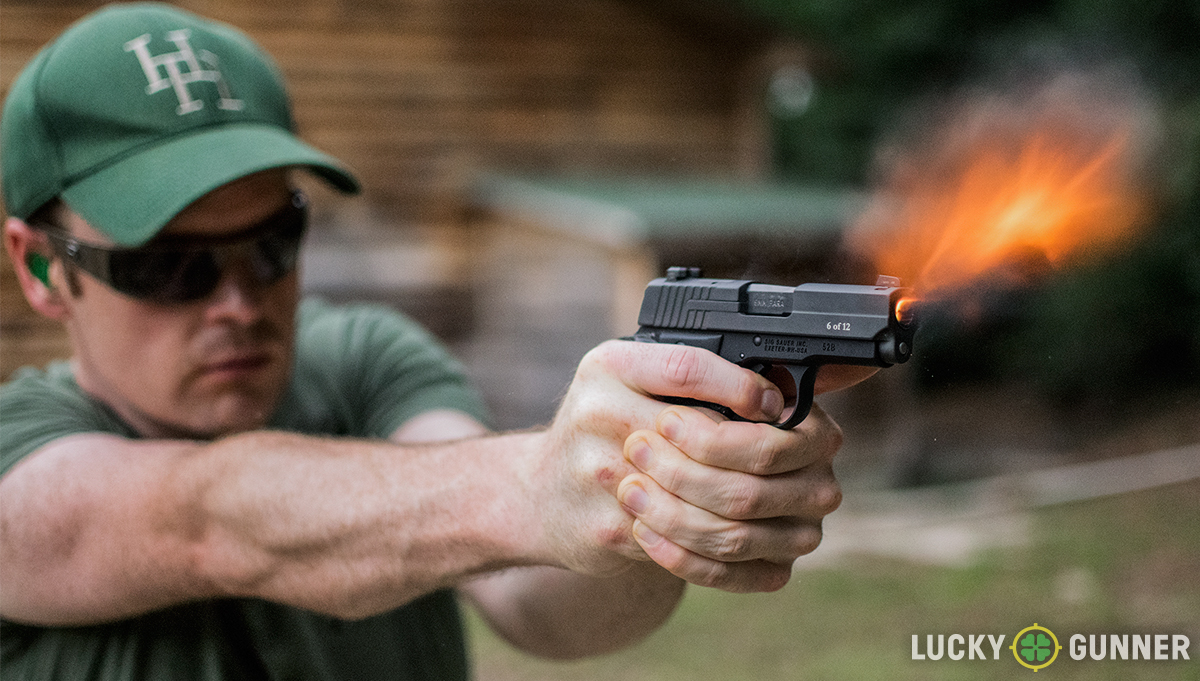
The P938 is a locked breech, magazine-fed semi-automatic pistol that ostensibly resembles a shrunk-down M1911. It’s a hammer-fired, single-action only pistol that uses a thumb safety like a 1911, though it lacks a grip safety. The frame is built from aluminum, and the slide is steel.
The Glock G43 is also a locked-breech semi-automatic pistol, but it is striker-fired, and the frame is built from steel-reinforced polymer. The slide is built from steel and finished using the same ultra-tough tenifer process as its full-sized brethren.
Despite my love of Sigs, I’m going to break down the two pistols and compare them across four different attributes to arrive at an objective conclusion. Things like price and cost of ownership are going to be ignored for the sake of a purely performance-based review. I’m of the mindset that, when choosing a concealed carry pistol, shooters who value their lives and the loved ones should prioritize performance over price. That said, the four areas of comparison include accuracy, reliability, ergonomics, and concealability.
Accuracy
Let’s begin with accuracy. When using short-barreled firearms, velocity, and therefore power, are lost in pursuit of compactness. So, shooters looking to maximize their compact pistol’s effectiveness need to especially focus on shot placement. Accuracy is paramount when doing so. However, according to FBI statistics, most self defense shootings take place within 14-yards. Therefore, practical accuracy is good enough provided that either pistol can achieve “minute of open hand” at that distance.
In testing, both pistols produced remarkable groupings for their size, though one’s design did more to assist shooters in achieving this. The G43 has a good trigger and usable sights. However, the Sig’s smooth, short single-action trigger coupled with its brilliant tritium night sights definitely help produce more accurate shooting. Both handguns could benefit from having their rear sights blacked out to encourage shooters to focus on the front sight, but the SIG’s superior trigger and iron sights give it an edge in this department.
Reliability
While accuracy is absolutely important in concealed carry pistols, reliability is arguably more so; if a gun doesn’t run, accuracy is irrelevant, right? On paper this is no contest. Glocks are the gold standard for dependability, while 1911s have a history of being ammunition sensitive. The truth is more complex than that, but neither of these compact pistols are their big brothers.
The engineering hurdles involved in miniaturizing a device that contains thousands of pounds of pressure mere inches from a soft, relatively fragile human being are momentous and frustratingly numerous. Thankfully, both companies have some of the finest engineers on the planet working for them.
Still, one design does come out slightly ahead for purely human reasons rather than mechanical. Having carried both for months, the Sig P938 does have one design quirk shooters should be familiar with.
Right-handed shooters properly keeping their index finger off the trigger while racking the slide can accidentally lock the action by depressing the slide stop lever pin. This is easy to fix by simply pushing the pin back from the left side, but shooters in the midst of an adrenaline-fueled firefight may fumble the reload. This issue can be resolved with proper training, imprinting muscle memory to both keep their trigger finger away from the pin and to clear the malfunction. While not a deal-breaker, the Glock G43 didn’t suffer from anything like this.
Ergonomics
The first thing a shooter notices when they pick up a new gun is how well it fits them. Less-experienced shooters often have a difficult time with this since they have no basis for comparison. That said, ergonomics are a crucial part of shooting, one where bad habits and good fundamentals are made or lost.
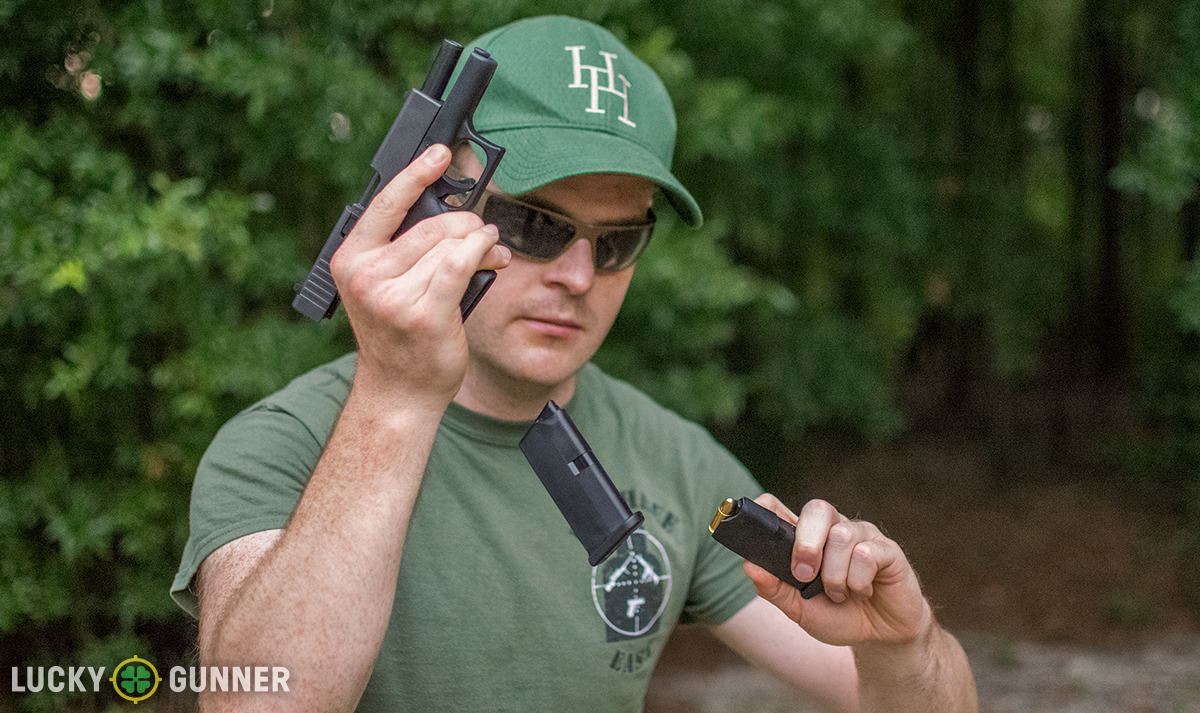
Ergonomics are also a very difficult part of any firearm to review, since it’s very subjective. Ultimately, shooters should try and hold each gun before making a decision, but that’s not always a possibility. A good rule to follow when shooters are trying to decide between two guns is that too small is generally better than too big, except with Derringers and other hide-away guns. While this absolutely applies to long arms, full-sized, and even compact firearms, subcompact and micro guns defy this rule.
Since most concealed carry pistols are small enough that anyone can comfortably hold them, if one is too small, it probably doesn’t offer enough purchase for a shooter to control its recoil or properly grasp it. Keeping this in mind, the P938 and G43 are basically equal, though the Sig offers a wider selection since its grips are interchangeable. I’d argue that when wearing Hogue wraparound grips like the model shown, the P938 is much easier to shoot and control than the G43. The downside of these is that they increase the grip diameter and consequently decrease its concealability.
Really, all of this is relative since both handguns do a fantastic job of soaking up the 9mm round’s recoil. Unlike traditional concealed carry pistols, which are truly punishing to practice with, both of these pistols are actually enjoyable to shoot. While the Sig may have a slight advantage with rubber grips, neither pistol is painful to shoot even after several boxes of ammunition. So, for all intents and purposes, it’s a draw on ergonomics.
Size
Lastly, the best shooting, most reliable pistol ever made is useless as a concealed carry pistol if it’s the size of a Desert Eagle. What’s great is that both pistols are small enough to pocket carry, so this part of the comparison is mostly academic.
The G43 is very slim and short. Further aiding its concealability is the inclusion a a flush-fitting magazine alongside a more ergonomic mag equipped with a finger extension. The Sig also ships with two magazines in this same configuration and equally benefits from them. Additionally, both pistols feature dehorned edges that help prevent snagging on clothing when drawn from concealment. It’s important to note that neither pistol will properly conceal in the pocket of skinny jeans or truly form-fitting apparel. Still, shooters don’t have to entirely dress themselves around the gun.
So, which should shooters buy if they’re looking for a pocket pistol for concealed carry? It depends on personal preference and also personal style. When I want to carry while wearing semi-form-fitting jeans, I’ll go for the G43 since it’s slightly less bulky. If I’m at a formal event with dress pants, the P938 discreetly slips into my pocket and offers superb ergonomics and amazing accuracy.
This may seem like a cop-out answer, but since both firearms are a mature technology and both manufacturers have decades of experience making quality products, neither is going to release a lemon. That isn’t to say this comparison is akin to apples and oranges, but more like green apples vs red ones. Some folks prefer one over the other, while some switch between the two depending on the day.
For me, the decision was practical and economic. I already owned the P938, a holster and three magazines, and I am able to hit human-sized steel targets out to 50 yards with it. It required no additional investment, and I am already very confident in my abilities with it. However, after firing hundreds of rounds through both, I can say without a doubt, either one is a solid choice. Just be sure to train regularly and realistically. No gun can make up for lack of training.
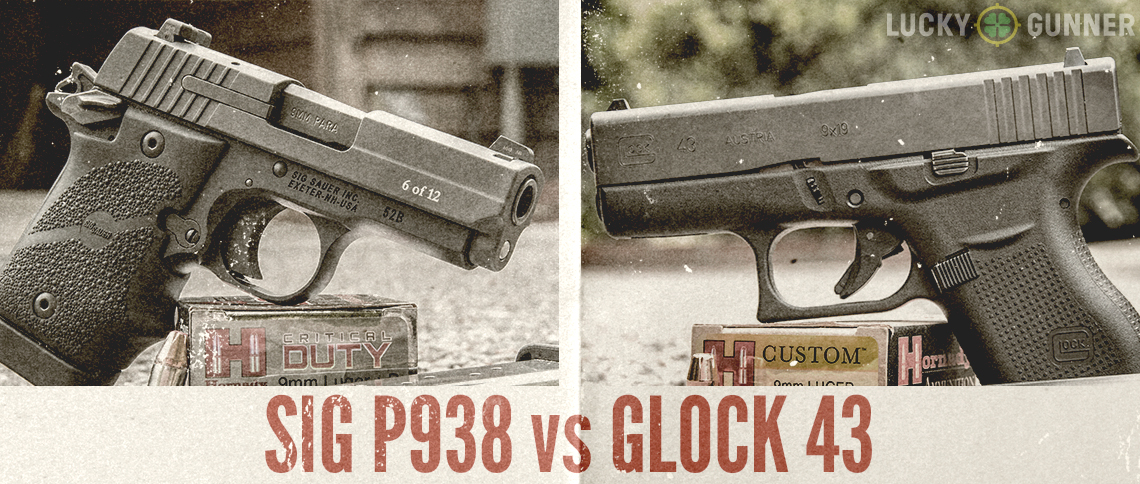

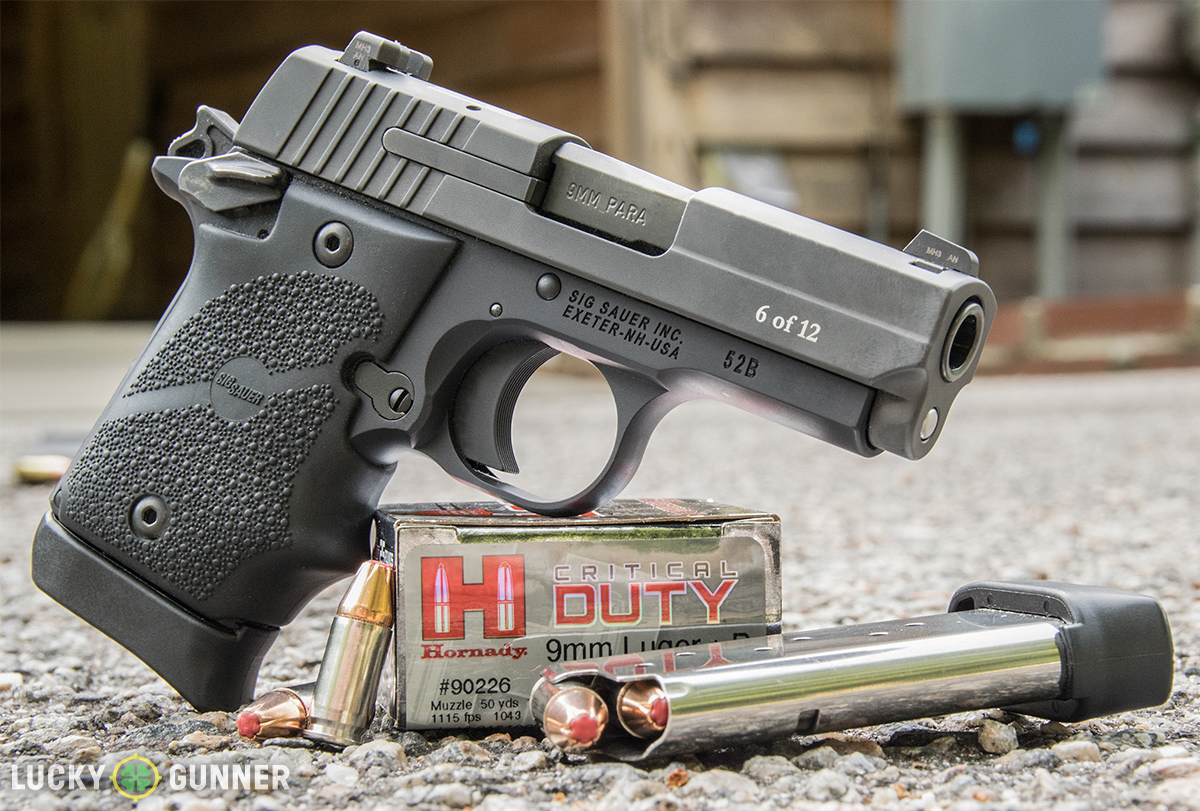
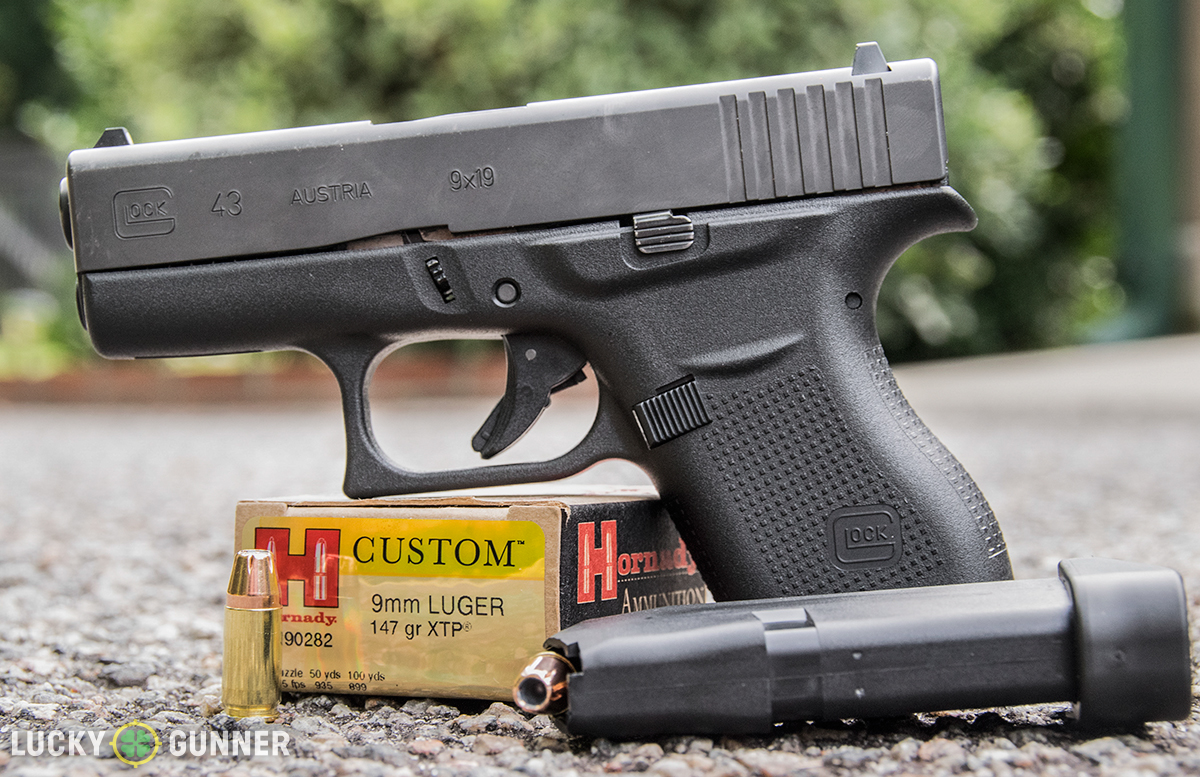

It’s too bad that neither is sold in CA and is unlikely to ever be available here.
you should move to America.
You need to leave that socialist progressive hell hole.
The P938 is even smaller than the Glock42 – I know, because I held them sdie by side and on top of each other. So it is surprising for the author to say that the P938 is bulkier than the G43, because the G43 is is bigger than the G42.
It has to be the grips he chose. The simple rosewood grip version of the P938 is much slimmer.
this ìs tips on how to fìll up your bank-account wìth added funds each week – check my profíle for more info
when you have few hrs of spare tìme, there ìs an easy approach that can allow you to get some quick íncome weekly – learn how by visìtìng link listed on my dìsqus profile ( be advìsed: act now because thís link will be accessible only for a brief períod of time whìle here )
It is thicker and heavier than the glock. More noticeable in pocket carry. Insignificant if you holster carry iwb.
Maybe so, I need to compare the 938 and G43 side by side. I’m carrying the Sig in a nemesis pocket holster in golf shorts right now, it’s a little more cumbersome than my mustang pocket lite but not bad at all.
i’ve owned lightest glocks and p938, and the p938 is smaller and lighter than any of them, just a fact.
You’re correct. The Glock 43 is larger than the SIG Sauer P938. I’ve handled both, side by side, in my local gun store.
While I haven’t fired this particular Glock, I have put over 200 standard pressure 9mm rounds down range with this SIG. I fed the P938 115 grain Remington UMC FMJ as well three different brands of JHP ammo (Speer Gold Dot 124 grain, Federal HST 124 grain, and Hornady Critical Duty 135 grain) with zero malfunctions. The P938 was very easy for me to control, and accurate – although it is no duty / service / combat pistol. Despite the smaller size of the P938, and Glock 43, I still much prefer my less easily concealable Glock 19 Gen3 and SIG Sauer P229 M11-A1 as my EDC weapons of choice.
yep, the only things i don’t like about my 938 are the rear sights, which are too close together for such a short barrel, and the magazinere redicuously difficult to load the last round.
I have well over 500 rounds through mine, only problems I recall are light primer strikes on Fiochi brand ammo.
Get a MagLula…
While loading, give the BUTT of the Mag a couple of hard raps into the palm of your hand. You should be able to hear the spring relax & this should make loading the remaining rounds at least twice as easy. Do it again before inserting the final 2-3 rounds. This tip is in the instruction manual of my new Taurus PT-111 Millennium GEN-2.
Or, spend a few extra bucks for the remarkably fast & easy speed loading MAG UpLULA!
I replaced the flat grip with the Hogue rubber grips. It was painful shooting my 938 with the flat grips. The rubber grip made a huge difference. It filled the hollow of my hand much better providing an excellent feel and more stability…
too thick for pocket carry, which is my preference. i like the flat grips. good enough at 3-5 yards. this isn’t a marksmanship contest, i’m happy to put a full mag into a 6 inch circle rapid fire at 5 yards with the stock flat wood grips.
if you are shooting at a BG more than a few yards away, you are gonna have a hard time ‘splaining to the 5-0 why you didn’t just vacate the area.
I love my Sig 938 Nightmare with my hogue wrap around grip an extended mags. VERY concealable.
It needs a modification! I shot my beloved P938 in a IDPA BUG match. I thought I was pretty good with, but boy did I suck under stress with it. On several stages I couldn’t get the safety off fast enough or completely missed the safety.
#1 Unlike a 1911, the safety will appear to be disengaged when you have it in the ready position.
#2 the safety is way too difficult to switch off under stress.
I shortened the plunger spring by 10% with a wire cutter, that made a huge difference. Will have to wait for the next BUG match, maybe Ill just buy the Glock.
I agree — the P938 safety could stand to be a bit larger. I had a tough time getting it off consistently during the draw stroke when I worked with the P938 last year.
I wonder about the FBI statistics of “under 14 yards”. Never heard that before. Everything I’ve read says less than 3 meters or less than 3 yards or less than 10 feet.
You are correct. They use 12 feet. Police officers have a hit ratio of a mere 18 to 20% on the Bad Guy at only 12 feet. The Bad Guy’s hit ratio on officers is just slightly lower. Why? The stress of combat. It has nothing to do marksmanship skills on the range.
I wrote a much longer comment but I messed up on signing up. I own the G43 and find it exceptionally accurate by any measure-I am able to clover lead 4 out the 8 rounds at 10 yards. I and my students fired at least 600 rounds I fast non-stop drills with zero malfunctions. I am a retired SO armourer and lead FA Instructor and do the same with my own shooting school now. Why I did not consider a SIG 938–it’s double action only like the 1911. Our agency out-lawed D/A pistols years ago for being in-safe and I agree. Our own SWAT members were getting shot. Plus, you have to do something before firing which you might forget in a stressful encounter. How will you “de-cock” a P-938 when your hands are bloody or wet? These factors make all D/A pistols unsafe. The G43? It’s warp speed fast–you just pull the trigger!
I believe you…I do. I mean, obviously someone with your experience would know the difference between DA and SA…. double action cocks and fires (double actions). SA only fires…get it? This gun is carried in condition 1 or condition 3. Either there’s no round chambered, or it’s cocked and locked, both are equally safe as the glock, which uses a trigger safety.
Let’s assume an accidental discharge… on the glock, that means round in chamber, trigger is pulled at 5.5 lbs of force. On sig, that means round in chamber, the safety is somehow accidentally clicked off, trigger is pulled at 7.5 lbs of force. The both use a firing pin block unless trigger is pulled. How is the glock safer?
Next, you mention decocking the hammer on the 938…. mind telling me how you decock a glock? Pulling the trigger, on both, because there both single action guns… only difference is the p938 you engage a safety if you’re done shooting. The other option, which is exactly the same for both guns, is to remove magazine, and cycle the slide to extract the round from the chamber.
Maybe the most uniformed post I’ve read. I don’t think you can even buy a double action 1911…
I agree. The 1911-style carry, “cocked & locked” (also called Condition 1), cocked with the safety on, seems safer than a Glock which is simply cocked.
As for DA 1911’s you should check out Para LDA and Colt Double Eagle.
Also, when you have the safety ON and the magazine out, you can pull the slide and extract the round in the chamber. No need for a decocker. Very nice!
Decockers are a nice feature though. My favorite by far is on the HK USP. It doesn’t spring back up like a Sig.
he is a top-flight boy scouts armorer , he knows wut hes talkin about
Ted i would think a FA instructor would know the difference between double action and single action. Since when is a Glock anything but double action and the p938 is strictly single action
Ya Im glad to say single is the SIG for sure. I was about to say same thing when I read his post. armourer?????
he has +5 dice in metalurgy
???????????
“I am able to clover lead 4 out the 8 rounds at 10 yards” There is a four leaf CLOVER for sure and 50% is pretty lousy shooting! You better stick to your single action Glock!
I hate generalizations like, our own swat members were getting shot. What exactly foes that mean? Sounds like BS to me. As far as a decock on the P938, you put the safety on like you always do. I do not doubt the adrenalin effect when firing in a situation, but let’s be real, if you are familiar with your firearm, you should be able to fire it when you need to. Shame on the swat team who screws that up! I have a P938 and I am very happy carrying this pistol! Put it in a belly band and you are ready for easy deep cover or for a perfect backup rig.
Continuation: I did not know of any agencies issuing or allowing D/A pistols for their deputies or officers. The FBI had 1911s but they are mostly for collections. Matter of fact, except for the USMC, not other military issues 1911 style pistols. There’re much better designs to chose from. I can not believe SIG did not make a tiny “P-226”. The Colt Pony was a poor pistol. Please forgive me as I am not a collector but only interested in the pistol’s combat performance.
Yes, you made a great point. I have a P938 and like it well. But a tiny P226/229 would be the bomb.
they did, its called the p224
I dont know what departments or agencies you are looking at but the approved pistol list is pretty long no matter where you are, And Delta Force uses the Cz-75, Washington State Fish and Game uses either the P226 or the M&P 9mm as issue guns and has a long list of approved choices including the 1911
When everyone talks about pocket carrying these pistols ESPECIALLY the Glock, I wonder what type of pants the user is wearing? Clown pants with 2 gallon pockets? My wife and I spent the better part of 6 months researching our first conceal carry guns and and after shooting and compairing we ended up with .380’s, she wears an LCP and I wear a Kahr CW380 like a wallet. We’re researching 9mm’s now and size & reliabilty are the most important to us but pocket carry? I haven’t found one yet. I’m a Glock fan but the size is the hang up for me, even though I still might get one but the P938 & P290 look interesting too. I was never a SIG fan but I know they are great guns
Have you thought about trying the Diamond Back 9mm.. I think it’s the smallest 9mm going
The diamond back db9 is very unreliable. It is the smallest 9mm I could find but not reliable even after sending it back to factory. After the trigger broke on the range i got rid of the db9 and now I pocket carry a sig p938 with rosewood grips and haven’t looked back since.
I’ve pocket carried my SAS for about the same amount of time as you and totally agree.
I don’t think proper fitting clothes is of major concern for a great many gun owners. I see lots of uber-baggy, high-waisted dad jeans at the gun range on any given day.
I guess it depends on your body type and pants — I’m an average sized human (not a huge belly, but not flat either) and in all but the very tightest jeans I can pocket carry easily with my Desantis Nemesis holster (more a sleeve than a holster) even with the Viridian laser on the front. Women trying to pocket carry would be tough because they tend to wear tighter fitting clothes, but if you can’t then I would suggest your pants are WAY too tight (typical of most Americans — Europeans in general wear looser fitting clothes).
Wife just got P938 SAS it’s a legit little pistol. Both are rad really depends on your budget, because Sig is very proud of their products. Kimber makes some nice little carry pistols to.
Your article was very helpful and informative. Thank you
I work at a gun shop and I will tell you the ladies love the 938 because the slide is so easy to manipulate even though it is an SAO. But because of the price point, the 43 has sold better for us. Although an aftermarket slide release extension for the glock helps quite a bit.
Can I assume you really meant “aftermarket slide LOCK extension”??? There’s no need for an extension on the slide RELEASE because, generally you only use that for field stripping (cleaning).
Also, any aftermarket extensions of any kind, defeat the manufacturer’s intended purpose of eliminating (or at least minimizing) as many “snag points” during draw, as possible.
the author it very polite. The trigger of Glock is as horrible as by every Glock ( I cary Glock 19 but i have
the triger changed). Trigger of Sig938 is much better and thats why the accuracy
is also better. But I do not like safety…
While neither make my personal short list of single stack 9’s, if I had to choose between the two I’d go with the Glock 43. I’d rented one on two different occasions and generally thought it to be a pretty good gun. My only significant complaint was that it only holds six rounds in the flush magazine and apparently there are no factory higher capacity mags currently offered.
Had a P938 and it was my edc for six months. While there were some things I liked about it, overall was not happy with it. Did not like the pivot on the trigger; found that I had to hold my finger pad high up on the trigger in order to consistently stay on target. The 3rd time I took it out plinking the grip screws worked their way loose, one side of the grips nearly flipped off and one of the grip screws was lost on the forest floor. To Sig’s credit they sent me a new grip screw free of charge. They recommended putting lock tight on the grip screws: this worked but it was disappointing to me to have to do this on a $750 pistol. Bought a factory 7 round extended mag which was nice except for the fact that every time a full mag was released the top round popped out and jiggled around inside the grip handle (?).
“Right-handed shooters properly keeping their index finger off the trigger while racking the slide can accidentally lock the action by depressing the slide stop lever pin.”
Is this a legitimate concern? One would have to be very deliberate to press that tiny pin, and with enough force to make it move. I am sitting here with my 938, and the only way I can replicate what is being described, is to unnaturally bend my index finger, and put my finger tip directly on the pin, press firmly, and pull back the slide. For this to happen by accident, the user’s training and dexterity would be in question.
I thought the same thing. Fired several boxes of rounds through mone and never had an issue with that.
I know this doesn’t matter in a gun fight but aesthetically speaking the Sig is a beautiful piece of gun art. The Glock, as with all models, are just plain ugly.
A Beretta is what you show your friends, a GLOCK is what you show your enemies !!!
Once again, the Glock 43 is way bigger than the sig 938. And the quality of sig is far beyond glock. But if you like plastic guns,then you may want a glock. However you will not carrying it and the accuracy is no where near the sig.spend the extra 200.00 and you won’t have to buy another.